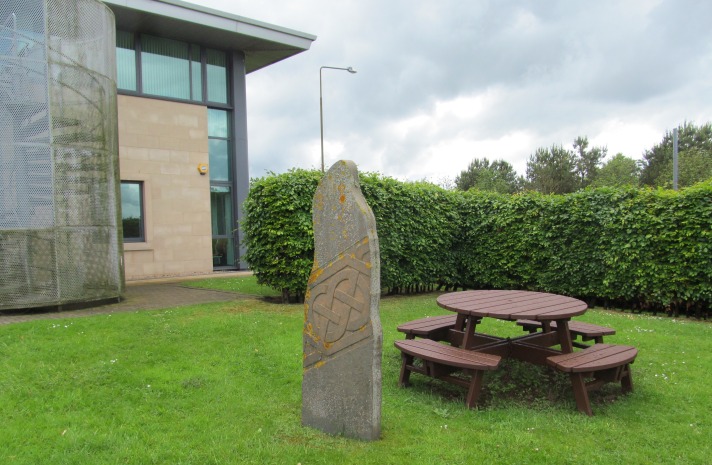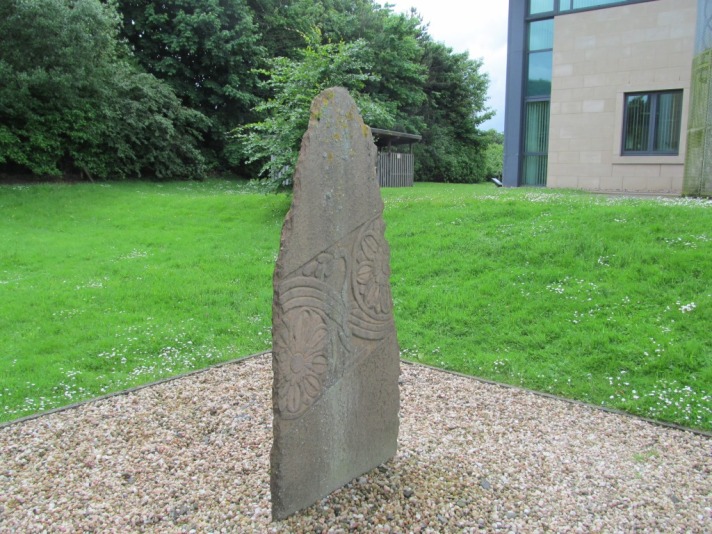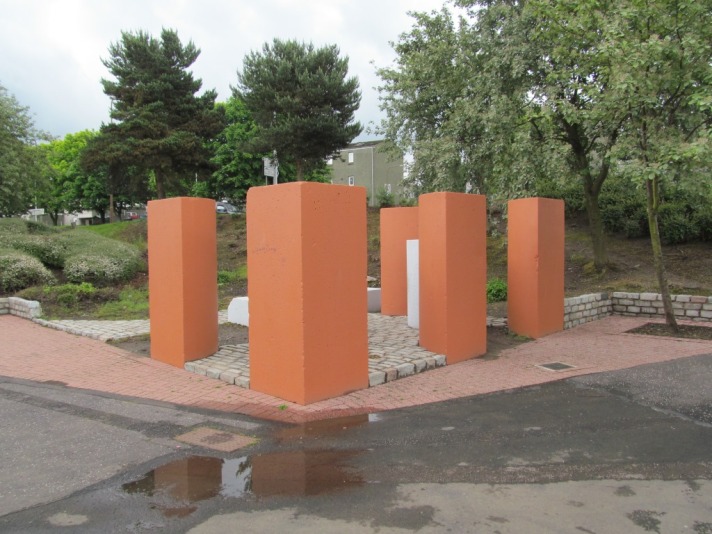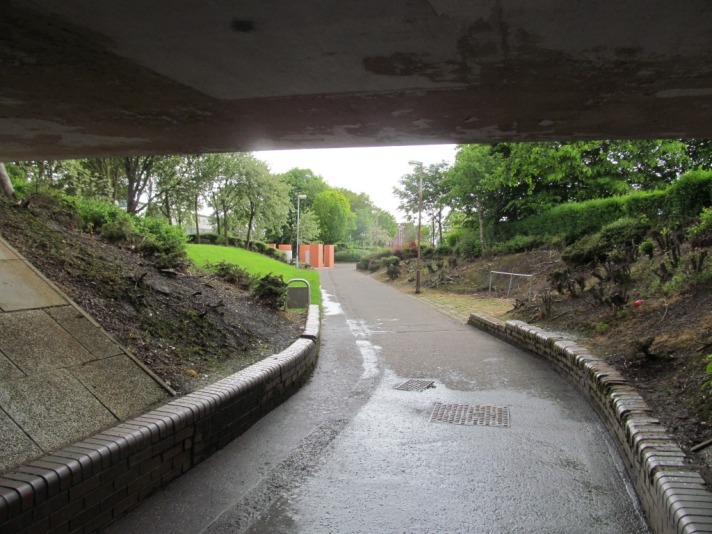The recent revival of media interest in ‘Brutalism’, a 20th century architectural style mostly associated with grey, chunky concrete office blocks, high rises and municipal buildings, is an interesting example of the ways that urban fashion can change dramatically, with buildings once seen as futuristic in terms of design and materiality becoming reviled and in many cases demolished, before in time being re-evaluated and treated nostalgically.
Of course, this trajectory reflects to some extent Glasgow’s Sighthill stone circle, as the recent article (which I co-wrote) in British Archaeology magazine suggests, but in this post I would like to explore a range of other connections, which will include Stonehenge and its concrete doppelgangers, 1970s artworks in the Scottish new town of Livingston and an architectural doctrine adopted by the Nazis.
But let’s start with the brutal and unforgiving form of Stonehenge.
Stonehenge has been characterised in many ways – awesome, spectacular, impressive and really expensive to visit.
But I think we could also describe it as brutal: imposing in form, cold in materiality, grey in colour and impassive in demeanour. This is, after all, a monument to death according to the recent Stonehenge Riverside Project and Mike Parker Pearson. A monument that would have no doubt caused the deaths and injuries of many in its construction over many centuries, a grim place which imposed itself on the landscape and the people of the 3rd millennium BC.

But of course Stonehenge was about so much more, and despite the appearances of the so-called concrete monstrosities that it spawned, the 20th century architectural style sometimes known as Brutalism was not really about grim-ness or grey-ness. It was about modernity, democracy, equality. It was about the future.
Like Stonehenge, Brutalism was ‘the futuristic funhouse fantasy of precipitous balconies sailing through the sky’ as Christopher Beanland has recently argued, with architectural flourishes including megalithic lintels, high rise trilithons and monoliths.

Indeed, I think Stonehenge shares many characteristics with Brutalist buildings. It is a monument about strength, it is ‘precisely functional’, and has at its core amazing simplicity when one gets beyond the awe and grandeur. The dramatic repetitive uniform sarsen blocks are the ‘repeated modular elements’ so favoured by modernist architects. Stonehenge was (and still is) transparent, with the internal workings visible from the exterior – in architectural terms, the ‘exposure of the building’s function’. The scale and angles created in the design of Stonehenge created crazy geometric arrangements that almost seem to be impossible. And many Brutalist buildings of the 1950s and 1960s were public buildings, places of work and learning, architectural foci for lots of people to gather, ‘civic megaliths’ as Beanland called them.
And of course, Stonehenge is now held up with a hell of a lot of concrete (usually hidden from sight as concrete is a material that can easily be disguised and hidden in many ways).
This is a material connection that seems to have been made by those who have made reproduction Stonehenges around the world, because these often consist of solid concrete blocks, arranged in sarsen-like trilithons. Achill-henge in County Mayo, Ireland, is a concrete version of Stonehenge that was built over a weekend in November 2011. This ‘protest’ monument is built of 30 or so concrete monoliths, each 4.5m high; blocks lies across the top, connecting these together, acting as lintels and completing the concrete trilithons. The Stonehenge memorial in Maryhill, Washington, is another concrete Stonehenge-alike. This is a memorial to US soldiers who died in the 1st World War, and construction was completed in 1929. Built of reinforced concrete, it consists of a complete exterior ring of trilithons, with various other concrete monoliths inside. And the New Zealand Stonehenge, Stonehenge Aotearoa (which I have blogged about previously) is made of concrete blocks including 24 external monoliths which support the inevitable continuous lintel motif.
The Stonehenge form seems to be universal, and in many cases concrete has been used, referencing the austere and blocky nature of the original, a monument that inspires brutal mimicry.
And it seems that other prehistoric monuments have in other ways become entangled with Brutalist architecture. Jonathan Meades has recently noted the inspiration that Bronze Age burial mounds were for the designers of concrete bunkers and gun emplacements in Germany in the 1930s and 1940s.
And Cornelius Holtorf has written of the role of prehistoric megaliths and ruins in the apparent Nazi doctrine of ‘ruin value’. “In a nutshell, what Speer and Hitler proposed was to build monumental architecture in the present in a way so that the ruins of those buildings in a thousand or more years’ time would still be impressive and speak favourably about the time when they were built”.

Therefore massive hideous concrete bunkers and flak-towers designed by the liked of Friedrich Tamms (whom Meades said was “arguably, the first brutalist”)were built at least in part with serious consideration as to how the building would look as a ruin once it had fallen out of use or ceased to have a function. This in turn would evidence the greatness of the culture who built them in the first place rather like the pyramids of ancient Egypt. Tamms himself wrote later of the incomplete but impressive form of German megaliths, a product of another of the ancient cultures the Nazis wished to connect themselves to.
But what does all of this have to do with Livingston? I went there recently on a fieldtrip to visit a series of artworks that mimic or are inspired by standing stones. This New Town, as with others in Scotland such as Glenrothes, developed with plenty of open spaces and public art, especially in the 1970s. This is celebrated in a really great booklet called Out in the open, a celebration of public art in West Lothian with a particular focus on Livingston.
My first stop was the Almondvale Business Park, where I wandered about for a while amidst lunching workers and car parks looking for two artworks called Floral Stone and Celtic Stone (both dating to 1995). These were located at either end of an angular building and more or less situated at the bottom of fire escapes.

The stones are thin angular slabs and they explicitly reference megaliths: Out in the open notes: “their monolithic nature makes them like prehistoric standing stones, a marker in the landscape, all the more powerful in a new urban environment as they seem to tap into ancient times”. In reality they tap into places where workers can have a fag, or in the case of the Celtic Stone, sits between some rather unprepossessing picnic tables in a small square hedged off area beside a road.
Around the business park, entrances to car parks were marked by huge chunky boulders with the name of various buildings etched into them, a roll call of business park banality: Barbara Ritchie House. Earlston House. Denholm House. Note to business park landscapers: big inscribed boulders don’t make the place any less banal.
From here, I visited a decidedly brutal piece of art nearer the shopping mall dystopia of the town centre – Standing Stones. This piece of work was erected in 1978 by the artist Denis Barns, and consists of a series of large cast concrete blocks, including tubes, cheese-segment like blocks, and some tall rectangular monoliths. Barns was the Town Artist at the time and this is a number of his artworks around the town. This piece was located right next to what was at that time the HQ of Livingston Development Corporation. Out in the open notes:
“at the time of construction, the whole area was carefully landscaped. The artwork would have stood sentinel near the entrance, conveying the timeless solidity of ancient obelisks together with the modernity of man-made material”.

The location has gone downhill a bit since then, with underpasses on two sides, the Council building no longer in use, and a rather grim car park just behind it. And at some point recently, the whole thing has been painted, transformed from the original Brutal Grey to an off-white and salmon combo.
Perhaps this was because, as the photo below shows, the monument was in 2003 covered in graffiti, although even the new lick of paint has not stopped subversive daubings / gratuitous graffiti on this piece of art.


This is a very strange piece of work, of course recalling the blocky Stonehenge sarsens, but also industrial pipes, and giant cheese triangles, as locals jokingly refer to the squatter elements of the monument. And of course it also surely draws on Paul Nash’s 1935 painting Equivalents for the Megaliths.

I am not sure how much this strange sculpture evokes actual megaliths, but it has a certain brutal charm that fits well with the Clockwork Orange location.
There is something brutal and Brutal about standing stones, because in some ways they share the ethos and appearance of modernist and Brutalist architecture. These are not direct equivalences of course, but perhaps allow a different way into thinking about prehistoric and 20th century structures, concrete or otherwise.
Sources and acknowledgements: my incredibly basic level of information about Brutalism came from a few media articles cited in the text above, as well as watching Jonathan Meades’ recent BBC series Bunkers, Brutalism and Bloodymindedness (and Wikipedia!). The Cornelius Holtorf material comes from a section of his amazing online thesis. Information about concrete trilithons in part comes from a paper I gave at the EAA Conference in Plzen in September 2013 (Something henge: an archaeology of Stonehenge replicas) which was jointly written with Glasgow University PhD student Rebecca Younger. The Flak Tower image comes from a webpage related to an Open Architecture project related to these structures, while the Nash painting is available widely online. The photo of the original form of the Livingston Standing Stones came from the Out in the Open booklet, the graffiti version from 2003 came from WLC Public Art flickr stream. The photo of Trellik Tower was sourced from an architecture blog, credited to Andy Spain.
This post was edited on 26th September 2016 to remove correct the wrong attribution of an artist to the works Celtic Stone and Floral Stone.








A very interesting piece. I get your point, but still, why is it that I dont find Stonehenge offensive in the landscape, but I do find a 70’s high rise block offensive? I think its the complete lack of aesthetics. Most things designed to be purely functional are not aesthetically pleasing. When I worked at Habitat, design was about function, form AND beauty. It worked. That blocky salmon painted piece of art you show has been so systematically vandalised, I believe, because there is nothing pleasing about it. One thing we know about our ancestors is that they endowed much of what they made with great artistry and intricate workmanship. As I have never been able to get close enough to the stones of Stonehenge to see, here in Ireland there is evidence of beautiful decorative carving on many of our stone monuments. They were not ‘brutal’ in any sense of the word, although the making and lifting of them may have been.
There are many modern buildings which are striking in terms of their futuristic form, yet still beautiful. I guess its all in the eye of the beholder… to me, those giant white wind turbines striding across our landscape in greater and greater quantities are quite beautiful and awe inspiring, but I know many find them truly ‘brutal’!
Thanks for all the insight . I love how you tied together Stone Hedge with your arguments on form and brutalist styles. I believe that midcentury modern represented the golden age of design. Why else would this genre be revisted.